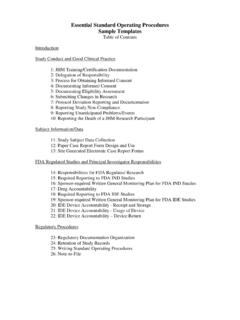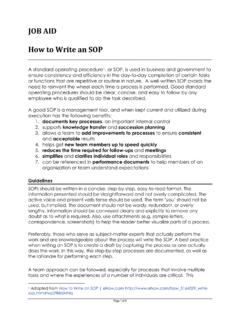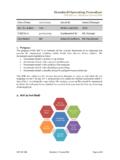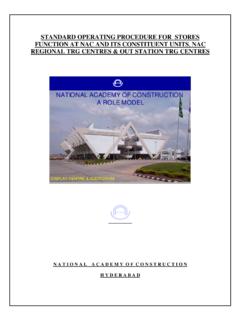Transcription of Standard Operating Procedure for Mobile Crane Operation
1 Standard Operating Procedure for Mobile Crane Operation2ndEdition October 2015 Our goal is the safe Operation of Mobile cranesIntroductionThis document is prepared to provide guidance for Maintenance of Traffic/Traffic Control Plan for the application submission for the Mobile Crane Operation , so they may be approved in a timely manner. Missing or insufficient information will delay approval. APPROVAL:Traffic Control Plan (TCP) or Maintenance of Traffic (MOT) plan for Mobile Crane Operation is submitted as part of a public space application to the District Department of Transportation (DDOT) s Public Space Regulation Division (PSRD). It will be reviewed by PSRD s Plan Review Division, the traffic/civil engineering :The Mobile Crane Operation TCPs must take into account any existing traffic control in the area adjacent to the proposed work zone.
2 (The area adjacent is a minimum of one block in any direction from the proposed work zone.) The Mobile Crane contractor is responsible for coordination with any adjacent work zone, including DDOT work zones, and special : The Mobile Crane Operation TCPs shall be subject to the review and verification by DDOT staff for compliance to submission requirements. Compared to other types of construction equipment and temporary work zones within public space, Mobile cranes typically occupy relatively large workspaces in three dimensions (3D) during any for Mobile Crane OperationThe workspaces of cranes are to be taken into account carefully prior to their Operation to reduce the potential for spatial conflicts between cranes and other components, such as building structures, existing utility lines, including overhead power lines, and other pieces of equipment, and temporary facilities located within proximity, resulting in hazardous work conditions.
3 This document provides a clear set of guidance for Crane workspace considerations and outlines the application process for Mobile Crane Operation through the Transportation Online Permitting System (TOPS).SUPPORT: Considerations for Crane selection should include the weights, dimensions and lift radii expected, the type of lifting to be done, the serviceability of the equipment and the site : Restrictions in using 220, 250-ton cranes, the following conditions must exist: Street must have a minimum width of 50 feet to accommodate radius of Crane . Entire street must be closed within the block where Crane is to be used. Prepare a traffic control plan to detour traffic around this block. Sidewalk must be closed to pedestrians within work area.
4 Traffic control plan must be tailored to fit contractor s specific situation. Permit invalid: If all required dimensions are not using a 220 tons and above Crane , state the reason why this Crane is used over any other type of Crane must apply for the Mobile Crane Operation permit and follow TOPS prompts and instructions. Make sure the Mobile Crane online application is filled out, including details of scope of work, and is complete. Upload MOT/TCP drawing for Mobile Crane Operation electronically. Upload Mobile Crane Technical Specifications for Mobile Crane OperationSUBMISSION REQUIREMENTS:MOT/TCP must be tailored to fit contractor s specific drawing for Mobile Crane Operation must be included and must meet the 1/7/2014 Traffic Control Plan (TCP) Submittal Guidelines, as a bare traffic control shall conform to the part -VI of the 2009 edition Manual on Uniform Traffic Control Devices (MUTCD), DC Temporary Traffic Control Manual.
5 Guidelines and standards 2006 Edition, DDOT Design and Engineering Manual -DC Department of Transportation, traffic control shall adhere to DDOT standards Specifications for Highways and Structures [the Gold Book ] 2013 Edition. Reference section Maintenance of Traffic, 603. Guardrails and guardrail Terminals ( ), 610 Traffic Barriers ( ), 612. Traffic Control ( ), Signing ( ), 617. Impact Attenuators ( ), 207. Trench Excavation and Backfill ( ), and 215. Excavations and Restorations /Utility Lines/ ( )APPLICATION REVIEW PROCESS:(For Mobile Crane Operation on Minor and Principal Arterials.) Review MOT/TCP for Mobile Crane Operation including online application, TCP drawings, or Detour Plans, and Mobile Crane Technical Specifications: The MOT/TCP drawing must be checked against the Detailed City Map, Geographic Information System (GIS).
6 The MOT/TCP shall be subject to review and verification by Plan Review Division staff that the MOT/TCP meets DDOT requirements. The Plan Review Division (PRD) engineer must go into the field for onsite inspection of the existing conditions of the site to ensure a match of the MOT/TCP submitted with the for Mobile Crane Operation The MOT/TCP drawing and field observations and notes are brought back to the office where the content of the MOT/TCP is checked against current District of Columbia standards pertaining to the traffic safety, pedestrian safety, accessibility, and mobility. Notes on the drawings shall be made in red ink to indicate any oversights on the MOT/TCP by the applicant. Additionally, reviewer may use online Reviewing Agencies Notes Text box for adding comments and recommendations addressed to the applicant.
7 Once the standards are verified, met and are satisfactory, the plan is stamped Approved. Minor modifications can be made to the drawing as the reviewer sees fit, however, modifications made should be short of redesigning the original MOT/TCP. All changes are to be made in red ink to distinguish them from the original markings. If standards are not verified and the drawing is incomplete, inaccurate to the point the reviewer would consider the changes to be too extensive compared to the original submission, or the area is too congested for any further projects at that time, or no plan is uploaded with the application, then the application should be stamped Revision Needed. SOP for Mobile Crane Operation Once the MOT/TCP has been designated as Approved, a copy should be made of the approved MOT/TCP s drawing by the reviewer.
8 The uploading process of the reviewed MOT/TCP drawing to TOPS should be done by an engineering technician of the Permitting Division. Once an application has been designated as Revision Needed , the TOPS automatically will inform the applicant about the problems with their application. The applicant can upload revised MOT/TCP drawing electronically to the reviewer for further processing. The applicant is given an opportunity to come in to discuss the problem with the reviewer and receive instructions on how to correct the problem if it cannot be done electronically through TOPS. The time for MOT/TCP review process starts immediately upon receiving technician E-mails on TOPS by the traffic engineer. The estimated time for review MOT/TCP drawing should be 10 working days (two weeks).
9 SOP for Mobile Crane Operation INSPECTION: DDOT/PSRD/ Public Space Inspections Division reserves the right to periodically inspect Mobile Crane work to ensure compliance, ascertain that safety measures are in place, and that the measures conform to the approved TCP and criteria listed on the recent edition of Traffic Control Plan Inspection Criteria document. PSI inspector must request to see the permit for Mobile Crane Operation and check the expiration date. EMERGENCY Mobile Crane Operation : Cranes that are used for emergency short-term work hours: Applicants for Emergency Mobile Crane Operation for life threatening situations such as hoisting an AC and Heating Units, large medical equipment, etc., are allowed to apply online for the Mobile Crane Operation permit without first going to Plan Review Division (PRD) for electronic review of MOT/TCP drawing.
10 PSI must be notified and deemed an emergency and authorized to begin work without a permit. The applicant must apply for a permit within three business days of the start of work. Emergencies on private property must be deemed an emergency from the Department of Consumer and Regulatory Affairs (DCRA) Inspections and verified through PSI. Then the applicant must proceed to Permit Office to purchase permits. Also this type of work does not need Advisory Neighborhood Commissioner (ANC) REVIEW PROCESS: (For Mobile Crane Operation on Local Streets and Collectors)Applications for Mobile Crane work on local streets and collectors do not require a review of the MOT/TCP by the Plan Review Division, except full street closures or partial closures, when trafficdetours are necessary.
















